A rolling stone gathers new LACMA fans
March 4, 2012
Tony Gendrano has never visited LACMA, but on Saturday morning, 340 tons of the museum’s latest acquisition paid an eye-opening visit to him.
“I said, ‘What’s going on here?’” the retired Rowland Heights accountant marveled, opening the blinds of his upstairs window. There, on the other side of the pane, sat the top of the 2-story-high boulder that’s been making its way this week to the museum.
Covered in white shrink-wrap, it gleamed like the Matterhorn in its bright red transporter, so close that it seemed to be peeping into Gendrano’s master bedroom. Down the hill, traffic jammed and crowds jostled along Pathfinder Road, which runs along Gendrano’s back fence—and which, coincidentally, was The Rock’s designated pit stop for the weekend.
“We’d been following the news about the project, all the excitement,” said Gendrano, who spent 35 years at the county Department of Health Services before his 2009 retirement, “but I never thought it would get this close to our house. When I was still employed, I walked one time on the street near the museum, but for some reason, I just never went inside it.
“I will definitely go now, though. I’m curious,” he said.
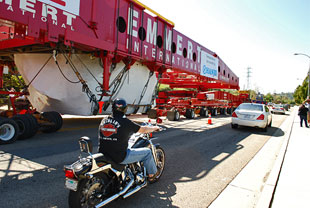
While hundreds of visitors intentionally dropped by Pathfinder Road to see The Rock, others came upon it accidentally.
The Rock’s 9-day odyssey across the Southland has been far more than a simple delivery from Point A to Point B. Since its late-night sendoff last Tuesday at a Riverside County quarry, the massive chunk of granite—part of “Levitated Mass”, a sculpture by earth artist Michael Heizer—has been gathering a whole new audience, both for LACMA and for art.
Gear heads have come to check out its transporter. Shutterbugs have taken its portrait. Schoolteachers have used it for lesson plans. History buffs have researched its provenance. Families have shown up with babies in blankets and grandparents in wheelchairs. Drunks have materialized at every stop, hollering and toasting. A Riverside County trucker proposed to his live-in girlfriend beside it. (“I wanted to give her a rock next to The Rock,” explained 35-year-old Ramon Vasquez III of Glen Avon.)
On Saturday morning, a man in a Rolling Stones t-shirt walked through the crowd calling it “Mick” (as in Jagger) and two Rowland Heights women rode up to it on horseback. Long lines of motorists drove by the transport apparatus, filming it on cell phones and yelling things at it.
“Roooooooooock!!” a carload of young men roared, revving their engine, as the boulder’s security detail looked mildly alarmed.
Many of the visitors say the spectacle has made them aware of the Los Angeles County Museum of Art for the first time; this has especially been the case at the early Inland Empire and East San Gabriel Valley stops. More than 60 percent of LACMA’s visitors come from within Los Angeles County, according to museum statistics, and so far, not one of the congressional districts The Rock has passed through has more than 500 paid LACMA members. By contrast, the Mid-Wilshire-to-Malibu congressional district in which LACMA is situated has more than 17,000.
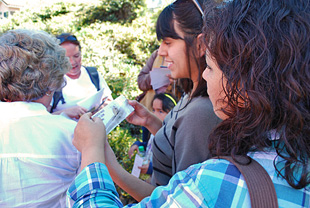
Taking advantage of the crowds, LACMA staffers passed out everything from bookmarks to free tickets.
“I can’t recall the last time I was at the museum, but I’ll probably go see this when it gets there,” said Irene Valenzuela, a purchasing agent for Smart & Final who was in the Rowland Heights crowd on Saturday with her husband, Art, and their granddaughter, Kaitlin Minton.
“I heard it cost, like, $10 million to purchase and transport it. For that kind of money, yeah, I want to check it out.”
LACMA officials didn’t engineer the enthusiasm, though they have come to view it as an opportunity as consciousness has built. Publicizing the move was initially tricky because permitting snags kept delaying the project. Also, several of the stopovers were on private property or in difficult-to-access locations.
Moreover, no one wanted the spectacle of the move to overshadow the finished sculpture. Until the boulder is fitted to a 456-foot-long concrete trench awaiting it at LACMA, it is only one component of Heizer’s artwork, which will allow viewers to walk underneath the megalith in such a way that it will seem to be levitating.
On the first night of The Rock’s journey, however, it became clear that this was one piece of public art that was destined to engage the public.
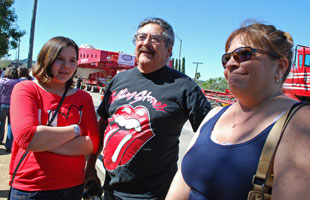
Rolling Stones' fan Art Valenzuela, with his granddaughter and wife, says LACMA's boulder should be named "Mick."
“What I really like is the way it’s making a public space,” observed Esther Amaya, a 20-year-old Cal Poly Pomona student discussing the boulder with her Whittier relatives at the Rowland Heights stop over the weekend.
“People are here talking, taking pictures, bringing their pets. Some are saying, ‘This is the stupidest thing I’ve ever heard of.’ Some are saying, ‘This is amazing!’ I think this is how you know it when you’re seeing great art.”
“Clearly, people are fascinated by it,” said LACMA Vice-President of External Affairs Terry Morello, noting that page views on the museum’s website have increased tenfold.
Docents have been on site at its stopovers since Wednesday, handing out informational bookmarks, free LACMA tickets and applications to NexGen, the museum’s free youth membership program. The museum also has reached out to schools with a downloadable “Levitated Mass” curriculum.
“We’ve easily given away hundreds of tickets,” said LACMA spokesman Scott Tennent, hustling to satisfy a crush of onlookers in Rowland Heights. “People seem so excited, not only about the artwork but also about the museum. Especially on the first nights, we met a lot of people who had no idea what LACMA was.”
Morello says that it is too soon to tell whether The Rock’s popularity will translate into increased financial support for the museum; the struggling economy has kept paid membership relatively flat for the last several years.
But museum officials have reason to be optimistic when it comes to increasing public involvement. In 2008, in concert with a major remodel, LACMA added another massive outdoor sculpture, an arrangement of antique street lamps by Chris Burden.
“Urban Light” is now an iconic Los Angeles artwork—and museum attendance has doubled in less than four years.
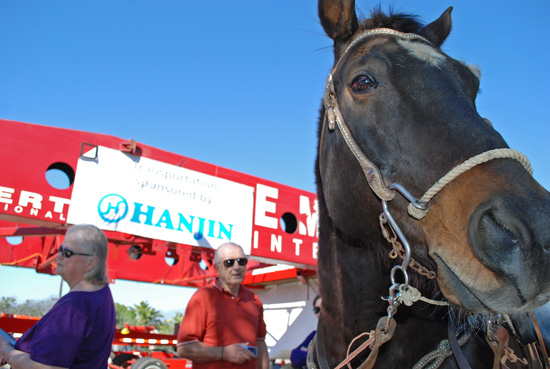
Among those in the diverse crowd in Rowland Heights was Guthrie, who trotted up with owner Debbie Scott.
Posted 3/4/12




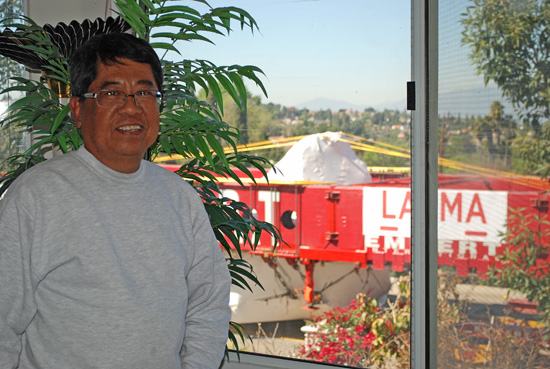








 405 bridge work causes a stink
405 bridge work causes a stink





